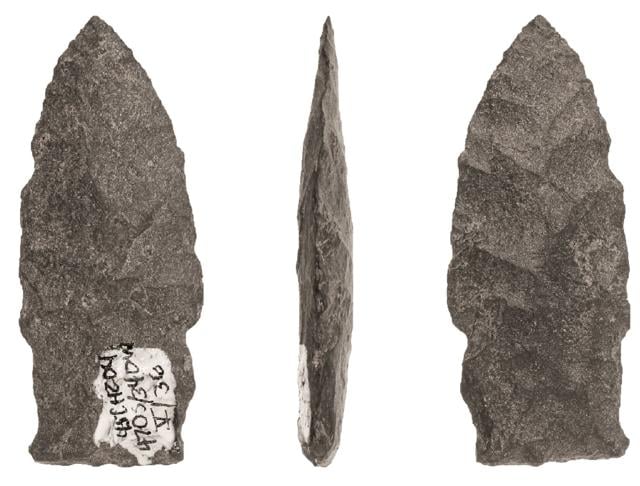WENATCHEE — Reanalysis of artifacts from a 1974 excavation of the Rock Island Overlook site dates the site much older than previously thought.
The residues of horses from an earlier Pleistocene era at the site, dubbed 45CH204, are now dated at 13,000-16,000 years old. (The nearby Clovis Cache is dated at 11,200 years old for comparison.) The site’s alphanumerical name is 45, which is Washington state, CH, for Chelan County, and 204 for the number, and the state protects its location.
Forty people attended a slideshow presentation and informational talk at Wenatchee Valley Museum and Cultural Center June 22 by Terry Ozbun, senior archaeologist with Archaeological Investigations Northwest Inc.
“It’s an outstanding and unexpected result,” said Ozbun of the reanalysis.
Stone tools, some with the horse residue found at the site in 1974, include bifacial blanks, knives, projectile points, drills, scrapers and flakes, which are a byproduct of the andesite rock, a basalt-like material.
Two members of the Confederated Tribes of the Colville Reservation, Jackie Cook and Guy Moura, directed archaeologists to return to the site based on a “hunch,” Ozbun said.
To return to the protected archaeological site, a “Memorandum of Agreement (MOA) was signed between Chelan PUD, the State Historic Preservation Offices, and the Colville Confederated Tribes (CCT) on July 10, 2018. The artifacts were on loan to AINW from the CCT repository in Nespelem in 2019,” said Jennifer Burns, Chelan County PUD environmental/cultural resource program manager.
A large amount of flakes indicated the site was “a workshop for making stone tools” and was old based on its location, Ozbun said. He has been a flintknapper and lithic technology specialist for 30 years.
The rock bottom of site 45CH204 has gravel from the ice age floods 15,000 years ago, and the stratigraphic diagram showed layers for the years since then. Pleistocene horses went extinct 12,700 years ago, and it wasn’t until the 15th century that Spanish conquistadors brought European horses back to North America.
Six pieces of the stone tool archeological artifacts were tested using three methods. Three of these artifacts had residues with evidence of the horses.
For the testing:
- First, obsidian was sourced by a lab in Corvallis that X-rayed trace elements to identify four mountain sources of the rock material in Oregon, ranging from 323-457 miles away.
- Second, the Willamette Analytics’ Obsidian Hydration Analysis measured the microscopic thickness of the artifacts compared to the artifacts found at four sites in Oregon: Eldorado, Coglan Buttes, Cougar Mountain and Timber Butte. The 45CH204 artifacts found were “really old based on this comparison,” Ozbun said, because they were thicker from absorbing water.
- Third, Ozbun said AINW does its own process of protein residue analysis. While there has been some pushback about how proteins can lodge in microscopic cracks and crevices for such a long time, it has become more accepted archaeologically, with demonstrations, that it works, he said.
Four other sites show evidence of Pleistocene horses: Wally’s Beach in Alberta, Canada; Cooper’s Ferry, Idaho; Wasden (Owl Cave), Idaho; and Paisley Caves, Oregon.
Washington state doesn’t make public the location of the overlook site. The cultural site boundary is managed by the Confederated Tribes of the Colville Reservation, Chelan County PUD and the Department of Archeology and Historical Preservation.



